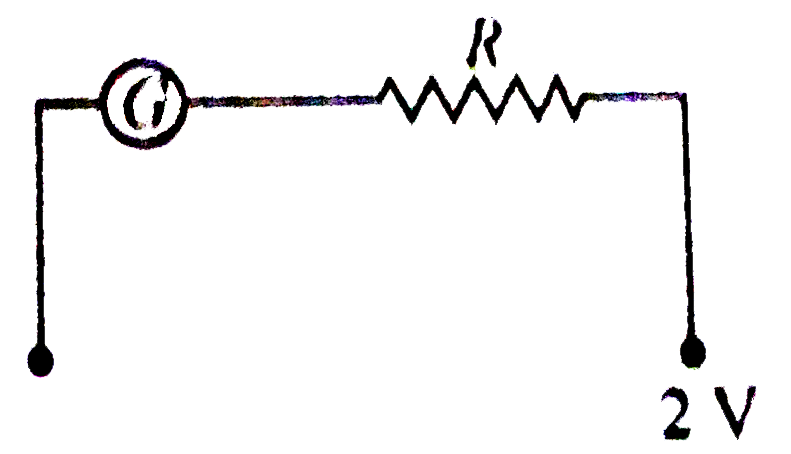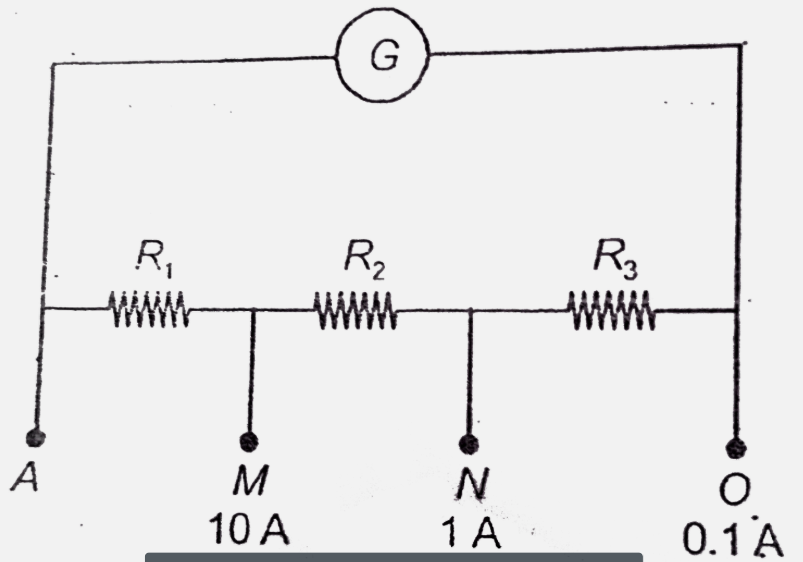Two galvanometers A and B require 3 mA and 5 mA respectively to produce the same deflection of i0 division. Then
A is more sensitive than B
B is more sensitive than A
A and B are equally sensitive
sensitiveness of B is 5/3 times of that of A
The correct Answer is:A
To solve the problem, we need to determine the sensitivity of the two galvanometers A and B based on the currents required to produce the same deflection.
1. Understanding Sensitivity:
The sensitivity S of a galvanometer is defined as the current required to produce a unit deflection (1 division) in the galvanometer. Mathematically, it can be expressed as:
S=1I
where I is the current required for a unit deflection.
2. Given Values:
- For galvanometer A, the current IA=3mA.
- For galvanometer B, the current IB=5mA.
3. Calculating Sensitivities:
- The sensitivity of galvanometer A (SA) can be calculated as:
SA=1IA=13mA=13mA−1
- The sensitivity of galvanometer B (SB) can be calculated as:
SB=1IB=15mA=15mA−1
4. Comparing Sensitivities:
To compare the sensitivities SA and SB:
SASB=1315=53
This means that the sensitivity of A is greater than the sensitivity of B.
5. Conclusion:
Since SA>SB, we conclude that galvanometer A is more sensitive than galvanometer B.
Final Answer:
Galvanometer A is more sensitive than galvanometer B.
The sensitivity S of a galvanometer is defined as the current required to produce a unit deflection (1 division) in the galvanometer. Mathematically, it can be expressed as:
S=1I
where I is the current required for a unit deflection.
- For galvanometer A, the current IA=3mA.
- For galvanometer B, the current IB=5mA.
- The sensitivity of galvanometer A (SA) can be calculated as:
SA=1IA=13mA=13mA−1
- The sensitivity of galvanometer B (SB) can be calculated as:
SB=1IB=15mA=15mA−1
To compare the sensitivities SA and SB:
SASB=1315=53
This means that the sensitivity of A is greater than the sensitivity of B.
Since SA>SB, we conclude that galvanometer A is more sensitive than galvanometer B.
Galvanometer A is more sensitive than galvanometer B.
Topper's Solved these Questions
- MAGNETIC FIELD AND FORCESBOOK - DC PANDEY ENGLISHCHAPTER - MAGNETIC FIELD AND FORCESEXERCISE - Taking it together
75 Videos
- MAGNETIC FIELD AND FORCESBOOK - DC PANDEY ENGLISHCHAPTER - MAGNETIC FIELD AND FORCESEXERCISE - Assertion and reason
20 Videos
- MAGNETIC FIELD AND FORCESBOOK - DC PANDEY ENGLISHCHAPTER - MAGNETIC FIELD AND FORCESEXERCISE - Medical entrance s gallery
59 Videos
- INTERFERENCE AND DIFFRACTION OF LIGHTBOOK - DC PANDEY ENGLISHCHAPTER - INTERFERENCE AND DIFFRACTION OF LIGHTEXERCISE - Level 2 Subjective
5 Videos
- MAGNETICSBOOK - DC PANDEY ENGLISHCHAPTER - MAGNETICSEXERCISE - MCQ_TYPE
1 Videos
Similar Questions
Two galvanometers A and B require 3 mA and 6 mA respectively, to produce the same deflection of 10 divisions. Then,
View SolutionA galvanometer has a resistance of 30 ohm and a current of 2 mA is needed to give a full scale deflection. What is the resistance needed and how is it to be connected to convert this galvanometer
(a) Into an ammeter of 0.3 A range ?
(b) Into a volmeter of 0.2 V range ?
View Solution
Knowledge Check
A galvanometer coil has a resistance of 15Ω and the metre shows full scale deflection for a current of 4 mA. To convert the meter into a voltmeter of range 0 to 18 V, the required resistance is
A5885Ωin seriesB4485Ωin seriesC5885Ωin seriesD4485Ωin series
If a current of 0.5 apere flows through a metallic wire for 2 hour then how many electrons flow through the wire ?
View SolutionA galvanometer coil has a resistance of 50Ω and the meter shows full scale deflection for a current of 5 mA . This galvanometer is converted into a voltmeter of range 0 - 20 V by connecting
View SolutionA voltmeter which can measure 2 V isconstructed by using a galvanometer of resistance 12Ω and that produces maximum deflection for the current of 2mA. Then the resistance R is

View SolutionA galvanometer vaving 50 divisions provided with a variable shunt S is used to measure the current when conneted in series with a resistance of 90Ω and a battery of internal resistance 10Ω. It is observed that when the snt resistaces are 10Ω&70Ω respectively, the deflection are respectively 9 and 30 dividions. What is the resistance of the galvanometer ? Further, if the full scale deflection of the galvanometer movement require 200 mA. find the emf of the cell.
View SolutionThe radius of the coil of a Tangent galvanometer, which has 10 turns, is 0.1 m. The current required to produce a deflection of 60∘(BH=4×10−5T) is
View SolutionDeflection of galvanometer in the circuit is 71 divisions. A shunt of 15Ω is connected parallel to galvanometer and value of R is adjusted such that main current ramains the same. If the deflection in the galvanometer falls to 15 divisions then the resistance G of galvanometer in (in ohm)

View SolutionThe galvanometer shown in figure has resistance 50 Ω and current required for full scale deflection is 1mA. Find the resistance R1,R2 and required to convert to convert it into ammeter having ranges as indicated.

View Solution
